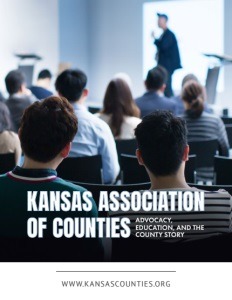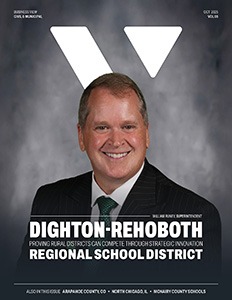Advocacy, Education, and the County Story
Empowering Communities with the Tools, Resources and Educational Assistance Needed
Counties form the backbone of Kansas communities. From maintaining roads and bridges to delivering public health services, housing programs, and emergency response, county governments touch every resident’s life in ways both visible and unseen. Yet the complexity of their work, much of it mandated by state law, is often overlooked.
That’s where the Kansas Association of Counties (KAC) steps in. Since its founding, KAC has served as the unified voice of the state’s 105 counties, providing advocacy, education, and technical advice to help local governments meet their obligations and serve their citizens effectively.
Executive Director Bruce explains, “Our job is to empower counties. We advocate on their behalf at the state and national levels, provide technical assistance and training, and build the tools they need to succeed. At the end of the day, everything we do comes back to serving the people of Kansas.”
Advocacy at Every Level
Advocacy is central to KAC’s mission. Counties in Kansas are tasked with providing 18 state-mandated services, from courts and corrections to elections and public health. To justify the property taxes that fund much of this work, KAC is currently collecting detailed data on the actual cost of delivering these services.
“This project is about transparency and accountability,” Bruce notes. “We want to show the public and policymakers exactly what counties are required to do, what it costs, and why property taxes are essential to meeting those obligations.”
KAC’s legislative advocacy extends beyond tax policy. The association works closely with lawmakers to address issues like housing, infrastructure, and economic development — areas that profoundly shape the state’s future.
Housing: A Growing Concern
Like many states, Kansas faces a housing shortage. Rising costs and limited availability make it difficult for communities to attract workers and sustain growth.
One promising initiative is the Housing Tax Credit Program, designed to stimulate new construction. Bruce highlights its early success in bringing more affordable housing to communities, but he also acknowledges the cost implications for the state. “It’s a balancing act,” he says. “We need to encourage development, but we also have to be mindful of the state’s long-term financial commitments.”
Counties, developers, and state agencies must work hand in hand to close the housing gap. KAC plays a critical role in keeping that dialogue alive, ensuring counties have a seat at the table.

Driving Economic Development
KAC also partners with the Kansas Department of Commerce to support business development across the state. The Department actively recruits investors, while KAC helps counties prepare for and capitalize on new opportunities.
Recent years have seen major successes. The Panasonic battery plant in DeSoto represents a multi-billion-dollar investment with enormous implications for local economies. Smaller niche manufacturing and agricultural projects also highlight Kansas’s diverse strengths.
Bruce notes that infrastructure remains a key factor in economic growth. “Investors look at roads, utilities, and housing availability when deciding where to locate. Counties play a direct role in creating the conditions that make Kansas attractive for business.”
Alternative energy projects — from wind farms to solar facilities — add another layer to the state’s economic development story, positioning Kansas as both a traditional and emerging energy hub.
Education and Engagement
Beyond advocacy, KAC is committed to educating and equipping county leaders. Training is offered through conferences, webinars, and specialized programs.
- The monthly “County Communicators” webinars, led by Kimberly Qualls, keep members informed on timely topics and emerging issues.
- The annual winter conference in Wichita attracts 400–500 county officials and 75–100 sponsors. The event blends training sessions, policy discussions, and networking opportunities, all designed to increase capacity and inspire innovation.
- Specialized training sessions and technical assistance programs give elected and non-elected officials the tools they need to navigate complex responsibilities.
“These events are about more than information-sharing,” Bruce says. “They’re about building relationships, learning from each other, and strengthening the county network across Kansas.”
Prepared for Emergencies
Kansas is no stranger to natural disasters. From wind and dust storms to blizzards and wildfires, counties are often the first responders.
KAC plays a vital role in supporting emergency management by facilitating communication, providing information, and strengthening partnerships with organizations like FEMA.
Bruce emphasizes the close-knit nature of Kansas’s emergency management community.
“When disaster strikes, our county emergency managers are ready. They know each other, they trust each other, and they step up for their communities.”
The County Story
One of KAC’s emerging priorities is telling the county story. Public understanding of county government is often limited, and misconceptions about property taxes or county roles can create friction.
“Our job is to help people see the value of their county government,” Bruce explains. “When you drive on a county road, vote in an election, or get help after a storm, that’s your county at work. We want Kansans to recognize that connection.”
By enhancing communications, launching a new Content Management System, and leveraging modern tools, KAC hopes to expand awareness of county contributions and challenges.
A Philosophy of Leadership
For Bruce, leadership in the association world requires both patience and strategy. One piece of advice has guided his career: “Never get mad at somebody who doesn’t have the power to do anything about it.”
In practice, this means focusing energy where it matters most — identifying the right decision-makers and engaging them constructively. “You have to find the person who can actually solve the problem,” Bruce says. “That mindset has served me well in advocacy and in life.”
This thoughtful approach reflects KAC’s broader philosophy: persistence, respect, and collaboration.
Looking to the Future
As KAC looks ahead, its priorities are clear:
- Continue advocating for counties at every level of government.
- Advance housing solutions that balance affordability and fiscal responsibility.
- Strengthen economic development partnerships to ensure Kansas remains competitive.
- Expand education and communication tools to equip members and tell the county story more effectively.
Above all, the association remains dedicated to helping counties deliver on their mandates while building thriving, resilient communities.

The Kansas Association of Counties is more than a professional organization — it is a lifeline for county governments navigating complex responsibilities, shifting economic landscapes, and rising citizen expectations.
By combining advocacy, education, and technical support, KAC empowers counties to fulfill their missions and prepare for the future. Whether it’s guiding policy debates in Topeka, training county commissioners in Wichita, or helping emergency managers respond to a wildfire, the association is there, ensuring counties are never alone in their work.
“Counties are where the government meets the people,” Bruce reflects. “When we support our counties, we’re supporting every Kansan. That’s the story we want to keep telling.”
AT A GLANCE
Who: Kansas Association of Counties (KAC)
What: The unified voice of the state’s 105 counties, providing advocacy, education, and technical advice to help local governments and residents
Where: Topeka, Kansas
Website: www.kansascounties.org


